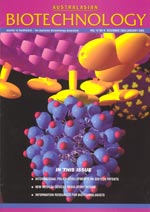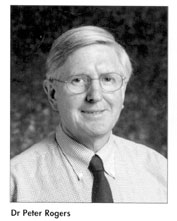
|
Australasian Biotechnology (backfiles)
AusBiotech
ISSN: 1036-7128
Vol. 10, Num. 2, 2000, pp. 2
|
Untitled Document
Australasian Biotechnology, Vol. 10 No. 2, 2000, pp. 2
FROM THE PRESIDENT - Whither Innovation?
Peter Rogers, National President
Code Number: au00015
In a recent address to the National Press Club, Sir Gustav Nossal was reported
as saying that promotion of private sector and public sector partnerships was
to solve funding problems. His speech was reported under a blunt header - ‘Greed
harms Universities: Nossal’ (The Australian 30/04/00). Sir Gustav was referring
in particular to the medical research industry and the doubling of government
funding for medical research over the next 5 years. Which still leaves a question
mark over the future of funding for the more fundamental sciences, such as physics,
chemistry and even engineering, as Sir Gustav rightly pointed out. The success
of private companies spinning off from public institutions has been spectacular,
albeit not for the faint-hearted over recent weeks.
But what is an appropriate level of support for fundamental science, and what
returns to the nation are there if support is increased? The US Council on Competitiveness,
an amalgam of academic and business interests is concerned about the erosion
of the US economy due to a flagging support of R&D. Despite the dominance of
the US today, the Council says that the need to support innovation is greater
than ever, if only to maintain the status quo.
The council has attempted to quantify innovation performance based on three
indicators:
- common innovation infrastructure (eg. basic science, IP protection, trade
policies);
- cluster-specific conditions that support innovation in similar industries
(R&D spend by companies); and
- the strength of the links between them (R&D spend by universities).
The Council has developed an innovation index, which is not meant to be taken
as a near-term measure of competitiveness, but rather a view of the potential
to sustain productivity, growth and competitiveness in the long term. It blows
the whistle on the US effort, fearing that the current rate of US national input
to R&D is declining (2.5% of GDP in the 90s compared to 2.74% in the mid 80s).
The US R&D spend is declining proportionally at a time when the spend in OECD
countries is catching up.
L.D. Simons, the Chairman of 3M, says that intellectual capital is the keystone
to competitiveness and this is because of the greatly diminished grace period
of market dominance for new products and technologies. As has been plain to
Australia, mobile economic activities that require moderate skills, capital
and technology can move offshore, and in fact began to do so in the 70s. Prosperity
depends on innovation, and we will need to mimic the US and become a moving
target, at the forefront in select areas, to meet the needs of international
and domestic markets and customers.
The US Council on Competitiveness leaves little doubt that public and private
R&D support is directly related through innovation to prosperity.
Some comparative innovation index values for the period 1975-1995: New Zealand;
8-9, Japan 82-119; Germany 63-104; Canada 22-37; Sweden 70-40; UK 42-36 and
the USA 150-145 (although it reached 180 in the 80s). Growth of R&D investment
in the US over the same period was almost 5%; for Australia the figure was 16%,
compared to 24% in South Korea and 15% in Ireland. On percentages, Australia
is moving well, but in absolute dollars and cents of course the US is streets
ahead.
We should be concerned about the funding of basic science and university-based
R&D infrastructure. And Sir Gustav Nossal is right to place the issue on the
Government’s agenda. The capacity for innovation, according to the US group,
affects the increased rate of economic growth, and indeed the prospects for
sustained increases in the standard of living. So, with this is mind, it is
nice to be able to report on some positive developments. Last month, GroPep
moved to stunning new premises in Adelaide. Hot on the heels of this move was
the successful debut of Bionomics on the Stock Exchange. Bionomics will share
the same facility as GroPep on the Adelaide Science Park. Hopefully the South
Australian Government which generously and very effectively supported both companies
will provide more support to the hospital-based R&D functions that have provided
much of the research base for these ventures.
Another positive indicator was the launch in March of the Food Industry Manufacturers’
Association (FIMMA) at John Furphy and Sons’ historic and very active site in
Shepparton. John Brumby, the Victorian Finance Minister, officiated and also
launched the Association’s new Directory. Many of the FIMMA members provide
services to the biotechnology industry in solids-separation technology, fermenter
design and fabrication and filtration. Mr Brumby emphasised the importance of
manufacturing innovation to regional Australia and to the wider manufacturing
community. Victoria’s food processing industry achieves over $4 billion pa in
exports and has the highest turnover per employee at $300,000.
The Queensland Premier continues to push his State’s technology program, especially
by personal attendance at the Boston Bio 2000 conference, and by recently signing
a collaborative agreement with the Massachusetts Institute of Technology. These
events suggest, as does the market, that our innovation index may be growing.
We have a collective responsibility along with the rest of the science community
to see that fundamental science is recognised and supported as an integral,
‘crucial’ part of the innovation and prosperity pathway. And to see that both
the public and private sectors provide their fair share of support for research.
Copyright 2000 - Australasian Biotechnology
|
